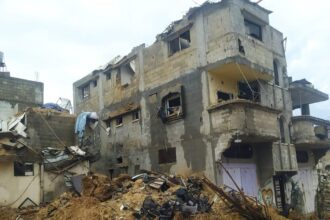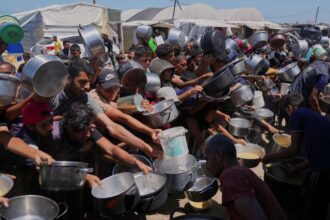Desperate crowds of Palestinians intercepted and emptied dozens of UN food trucks in Gaza City on Sunday, a stark manifestation of the deepening humanitarian catastrophe that continues to unfold in the besieged territory. This incident, occurring in the Zeitoun neighborhood, underscores the deteriorating conditions as the Israel-Hamas conflict enters its eighth month with no resolution in sight.
“What we witnessed represents a complete breakdown of civil order driven by sheer desperation,” said Philippe Lazzarini, head of UNRWA, the UN agency for Palestinian refugees. “These aren’t organized criminal actions but acts of survival from a population pushed beyond human endurance.”
The World Food Programme confirmed that 12 trucks carrying essential food supplies were intercepted before reaching their intended distribution points. Local witnesses reported that hungry residents swarmed the vehicles, offloading flour and other basic necessities while UN personnel stood helplessly by, unable to prevent the spontaneous redistribution.
This incident occurs against the backdrop of what international aid organizations have described as a manufactured famine. According to the Integrated Food Security Phase Classification, over 1.1 million Gazans—half the territory’s population—face catastrophic food insecurity, with children particularly vulnerable to malnutrition and its long-term developmental consequences.
The humanitarian crisis has been exacerbated by Israeli restrictions on aid entry points and the collapse of internal distribution networks. While Israeli officials maintain that sufficient aid is permitted to enter Gaza, UN officials counter that the volume falls dramatically short of minimum requirements and is frequently obstructed by security procedures and ongoing military operations.
“The discrepancy between what enters Gaza and what actually reaches civilians has become a matter of life and death,” said Martin Griffiths, UN Under-Secretary-General for Humanitarian Affairs. “When people are starving, the predictable outcome is exactly what we saw today—desperate measures to secure food by any means necessary.”
The breakdown in food distribution coincides with intensified fighting in Rafah, where Israeli forces have expanded operations despite international concerns about the safety of over a million displaced Palestinians sheltering in the area. Humanitarian corridors promised by Israeli authorities have proven insufficient to meet the scale of need, according to aid agencies.
Israeli government spokesman David Mencer defended the military’s approach, stating, “We are making every effort to facilitate humanitarian aid while maintaining necessary security measures to prevent Hamas from diverting resources.” However, multiple international organizations have documented systematic impediments to aid delivery that extend beyond legitimate security concerns.
The economic impact of the conflict has devastated what remained of Gaza’s infrastructure. Markets have collapsed, local food production has ceased, and inflation has rendered basic commodities unaffordable for most families. The World Bank estimates that rebuilding Gaza’s economy will require billions in international assistance and years of sustained investment—a prospect that seems increasingly remote as destruction continues.
As food insecurity worsens, health professionals warn of the long-term consequences. “We’re seeing not just acute malnutrition but the beginnings of a generational health crisis,” explained Dr. Rik Peeperkorn, WHO Representative for the occupied Palestinian territories. “Children who survive severe malnutrition often face lifelong cognitive and physical impairments.”
The international community’s response remains divided. While numerous countries have called for an immediate ceasefire and unimpeded humanitarian access, diplomatic efforts have yet to yield sustainable solutions. The latest UN Security Council resolution demanding increased aid flow has had minimal impact on ground conditions.
As night fell over Gaza City, the emptied trucks stood as symbols of a humanitarian system unable to meet overwhelming need. For Gazans, the daily struggle for survival continues with diminishing hope for resolution. The fundamental question remains: in a conflict where food has become weaponized, how can the international community ensure that civilian populations do not bear the brunt of political and military calculations?

























